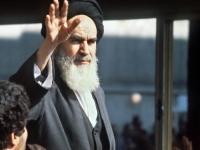BROOKE GLADSTONE: The media have been quick to associate this week’s protests with those that took place 30 years ago when the pro-Western Shah of Iran was forced to flee and the Ayatollah Khomeini made a triumphant return after 14 years in exile to fill the power vacuum. To get some sense of how these two periods of unrest may or may not resemble each other, we spoke to Youseff Ibrahim, who was installed as The New York Times Iran bureau chief in the Fall of 1978. The job called for a seasoned pro, so we asked Ibrahim if he got the job because of expertise in things Iranian.
YOUSEFF IBRAHIM: Not at all. I didn't know the country. I just landed there in the middle of the night. It was my first foreign assignment [BROOKE LAUGHS], and it was presented to me by the then executive editor of The New York Times as, you've done well here on the business desk and we're going to try you out as a foreign correspondent, but I'm sending you to a quiet place.
BROOKE GLADSTONE: Abe Rosenthal told you -
YOUSEFF IBRAHIM: Correct.
BROOKE GLADSTONE: - you were going into a piece-of-cake job. When did you begin to understand that what was going on was a revolution?
YOUSEFF IBRAHIM: It takes a while. And in the beginning it was a bunch of students throwing stones at a very harsh army. And then you began to see that it was catching. You began to see the doctors, the syndicates, the professionals. Then you began to see the middle class coming into the street. And then you began to see the clergy, which was the - really the tipping moment, because the clergy in Iran has the total loyalty of the mass population of Iran.
BROOKE GLADSTONE: So can you remember then what you were thinking on January 16th, 1979, when the Shah actually left the country? We have a little bit of tape to jog your memory.
[CLIP]:
MALE CORRESPONDENT: It was, as far as the people were concerned, total victory. The man they had condemned, the man they had said must be brought down, has finally gone, and the city went delirious with joy.
[CHEERING]
[END CLIP]
YOUSEFF IBRAHIM: That’s a goose pimple moment. And the bigger moment, which was simply unbelievable, was when Ayatollah Khomeini arrived. I mean, that was – I suspect I will never see a sea of humanity like that ever again.
BROOKE GLADSTONE: So watching what’s happening in Iran now, do you agree with the many journalists who see parallels with the revolution 30 years ago?
YOUSEFF IBRAHIM: The problem with the parallel is because a lot of these reporters today are in the midst of it, they tend to grab for the easiest possible common denominator. We get to a position now where we are describing one candidate, Mousavi, as a reformer and the other one as the hardliner. But if we look at the history of Mousavi, I mean, he was, after all, prime minister from ’81 to ’89 under Ayatollah Khomeini. There were hundreds of executions that he supervised. The man is a killer.
BROOKE GLADSTONE: But as a reporter watching this, any sense of deja vu?
YOUSEFF IBRAHIM: Yes, of course, there is deja vu. This is a movement, and this movement is growing. But even if these elections are cancelled, we will have new elections, and it'll still be between essentially these two people. What will happen, however, is that the regime would have blinked, and that’s a very important thing -
[MUSIC UP AND UNDER] - because it prepares - the way for the next rebellion.
BROOKE GLADSTONE: Thank you very much. YOUSEFF IBRAHIM: You’re welcome.
BROOKE GLADSTONE: Youseff Ibrahim was The New York Times bureau chief in Iran during the Revolution of 1978 and 1979.
BOB GARFIELD: This is On the Media from NPR.
[MUSIC UP AND UNDER]
